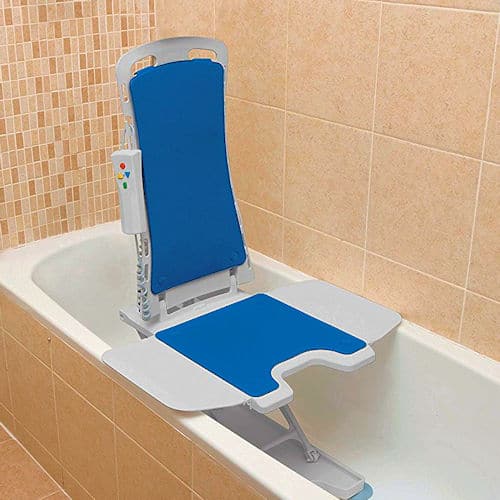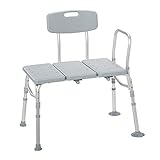For people with mobility concerns or who are advanced in age, the simple act of cleaning oneself and having a bath can be dangerous or even life threatening without the use of proper assistive equipment. This is where a bath lift can be a boon for those who find getting in and out of a bathtub a challenge, if not completely impossible.
In this article, we will answer the question, how do bath lifts work. We will also discuss who all can benefit from bath lifts and what other bathroom assistive technologies are available.

Most bathtubs at home are low in height and can have a slippery surface because of soap and water. Hence, getting in and out of a bathtub unaided can be difficult and dangerous, especially for people with mobility concerns.
Bath lifts come in many different styles and sizes for various types of bathtubs. They can include features such as anti-slip base grips and secure straps for use with individuals who may be prone to moving around when being lowered into the tub.
Contents
So, how do bath lifts work?
A bath lift is an assistive technology device that is made to help lower and raise individuals into and out of a bathtub comfortably and safely without putting additional strain on the user or the caregiver.
Bath lifts are usually made out of a mesh material to allow it to be used in water without wear and tear. They are designed with two wings to extend over the edges of the tub when raised. Once the user is safely within the bath lift, it can be lowered to sit nearly flush with the base of the tub. When the bath is completed, the seat can be raised up again to help the individual easily leave the tub. This allows the user to enjoy their bath without concerns of slipping or falling when trying to exit the tub.
Bath lifts are primarily used with traditional bathtubs, and can allow individuals with limited mobility to enjoy a bath that they may otherwise be unable to do without assistance. A bath lift is a worthwhile investment for anyone who has issues sitting or standing up at a low angle, or who finds entering and exiting the tub without the aid of another person impossible.
Indeed, shower chairs and bath lifts can add a measure of independence in the life of someone seeking to age in place. Many users appreciate the privacy that they can have while going in for a bath if they use a bath lift.
Often, bath lifts are combined with other forms of in-home assistive bathroom technology, such as bath chairs, transfer benches and wall grab bars. This makes life much easier for people seeking to age in place or patients with mobility concerns.
Bath lift chairs can help make any home bathroom more accessible to people who may be wheelchair-bound, or those who may be less steady on their feet than they once were, such as elders or patients with knee or back problems.
Bath lifts are also useful for individuals who may be the primary caregiver of a person with severe mobility issues or a cognitive impairment, and is looking for added safety for their ward while bathing, as well as ease of transportation from one location to another without fear of injury.
Bath chairs are a useful and a cost-effective option for situations where a full bath upgrade, such as the installation of a standing bath, is not possible. Here are some of the ways that a bath lift can help a wide range of individuals enjoy a nice, warm bath without the fear of injury or other frustrating, and possibly painful, complications.
You might also like Best Sliding Transfer Benches With Swivel Seat
Who Can Benefit From a Bath Lift?
Bath lifts are useful for people with arthritis. It can allow them to enjoy long soaks in the tub to help alleviate some of the discomfort in their joints, without causing them more strain by raising and lowering themselves into the bathtub.
Due to the discomfort and mobility restrictions that can be caused by arthritis, getting in and out of the bathtub can become nearly impossible. For many people the struggle required to accomplish the task of bathing can outweigh its benefits.
Some arthritis patients also complain about the loss of privacy and/or independence while having a bath and thus a reduced quality of life.
A bath chair can help ensure that the transfer process from one location to another is as smooth as possible, and can help take some of the stress off of the patients’ joints, allowing them to sit back and enjoy their bath. As a consequence, this can add a level of independence and improve the quality of life of someone suffering from severe arthritis.
Bath lifts are also useful for individuals who are wheelchair-bound or cannot easily stand up and place themselves in the bath.
You may like to read our article about transport wheelchairs to use after injury
Most bath lifts can be raised to meet the level of a wheelchair or a transfer chair. This means that moving from one position to another is smooth and fluid.
And, unlike a shower chair or other forms of shower-assistive tech, a bath chair does not require the installation of a removable shower head to be fully useful.
Bath lifts can be incredibly helpful for people who are the sole care provider to a patient with dementia or other mental health concerns, where having them move unaided from one location to another is not possible.
A bath chair can be outfitted with securing straps to ensure that the person in the chair does not fall off while being transferred.
A bath chair can also help make sure that the person being bathed does not accidentally slide down into the water, which can be a big risk for the patient who is not fully aware of their surroundings.
Bath lifts can make it easier for a caregiver to maneuver the patient. Bath lifts can help take care of a patient’s safety while bathing. This can free up the caregiver’s attention to the patient’s other needs.
Bath lift lifts can also be a good investment for patients who are undergoing a temporary, but more long-term treatment, such as patients in the recovery period after a hip replacement or knee surgery.
They can allow the patient to continue to bathe as they normally would without putting additional strain on parts of the body that are currently healing. In the case of a temporary injury or illness, a bath chair may not be as big of an investment as a standing bath or other forms of permanent bathroom overhauls would be.
A bath lifts may not be the right assistive technology for everyone, however. For some people, more permanent bathroom assistive technology options may work out better in the long run. Or they may be looking for other temporary bathroom assistive technology options to make their house more accessible for individuals with mobility issues. In these cases, other products may be needed to make any bathroom space more accessible.
Here is a YouTube video demonstrating the use of a bath lift chair:
You might also like Best Patient Lifts for Home Use
Other Forms of Bathroom Assistive Technology
When it comes to bathroom assistive technology, most of it is aimed at helping an individual get from one place to another easily. This includes things like transfer chairs, bath chairs, and wall grab bars.
Transfer chairs are less specialized than bath chairs and can be used to move a person from one location to another in confined spaces.
Transfer chairs are useful for moving from a wheelchair or seated rollator walker to a secondary location, such as a toilet seat, a transportable commode, or a shower chair. They can be used to help a person get past the raised edge of a combination bath and shower device.
Wall grab bars are useful to provide added stability to someone who is capable of lowering or raising themselves to enter or exit a bathtub or a shower. They can also provide additional stability when moving through areas with a high fall potential, such as over wet tiles or slick wooden flooring.
Wall bars are most often installed on the outside of a tub or shower area. They can also be placed along the wall next to a toilet or sink to aid a person who may need added support.
Wall bars can come in styles that are easy to attach and remove from the wall as needed. This makes them a versatile tool to help with balance for people who have difficulty moving from one location to another.
Transportable or bedside commodes are useful for people who find themselves confined to one location. They are also useful for people unable to make it across the house or up a flight of stairs to use the bathroom.
A transportable commode is made to be easily set up in a discrete corner of a room so it can be used in privacy and comfort. Transportable commodes come in many different styles, and can be combined with assistive equipment like Roho cushions and collapsible screens for added comfort and privacy during use.
Other accessibility additions for both the home and the bathroom include shower chairs and retractable shower heads. Shower chairs allow a person to sit down while showering. Handheld shower heads, can make it easier for someone with limited mobility who is using a shower chair to wash various parts of their body unaided.
You might also like Best Swimming Pool Lifts for Elderly
Conclusion
While many of these devices may seem simple in nature, with the added help of things like bath lifts, shower chairs, and wall bars, an individual with limited mobility can regain a large amount of freedom and confidence in their own home. This can protect them from possible fall risks and injuries and really help increase their quality of life.




